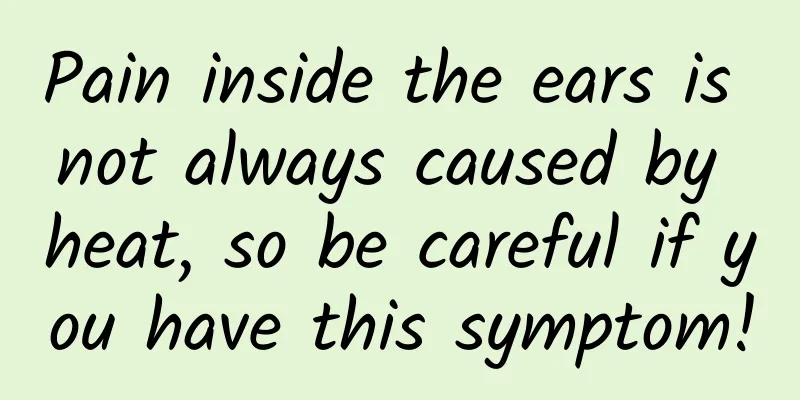Pain inside the ears is not always caused by heat, so be careful if you have this symptom!

|
Does ear pain necessarily mean it’s caused by inflammation? Ear pain is not necessarily caused by heat in the ear. The severity of the ear pain can be used to identify different diseases. So what symptoms do these types of ear pain represent? 1. Accompanied by fever, severe ear pain, stuffy ears, hearing loss, pain relief and improved hearing after pus discharge from the ear canal, it may be acute suppurative otitis media. 2. Hearing becomes worse and worse, and symptoms such as stuffy ears and tinnitus appear. If water enters the external auditory canal, the symptoms worsen and cause ear pain. Possible diseases include cerumen embolism and foreign bodies in the external auditory canal of children. 3. Symptoms After suppurative otitis media, the skin behind the ear will become red, swollen, and painful, which may be accompanied by headache and fever on the same side. There will be obvious swelling and tenderness behind the ear, and even local fluctuation. This may be a subperiosteal abscess behind the ear. 4. The pain worsens when the earlobe, auricle or tragus is pulled, the external auditory canal becomes red and swollen, with exudate or pus, which may have a foul odor; or it may appear as erosion, desquamation or scab. This symptom may be otitis externa. 5. Headache on the affected side occurs on the basis of a history of acute or chronic suppurative otitis media and mastoiditis, which develops into a general headache and projectile vomiting, which may be otogenic meningitis. 6. Long-term history of ear discharge, with bloody or blood-purulent secretions, initial dull pain in the ear, and later persistent dull pain deep in the ear, radiating to the temporal and occipital regions. Ear pain worsens at night, often accompanied by headaches, dizziness, facial paralysis and other symptoms. This may be middle ear cancer. 7. If the ear pain starts after taking the plane, accompanied by tinnitus, deafness, and ear discharge, it may be secretory otitis media. If secretory otitis media is not treated in time and the fluid in the ear is not absorbed, it will lead to secondary diseases such as tympanosclerosis, adhesive otitis media, cholesterol granuloma, etc., causing permanent hearing loss, which is very difficult to treat. 8. Symptoms: Paroxysmal or stimulatory vertigo may occur after suppurative otitis media, accompanied by nausea, vomiting, and spontaneous nystagmus. Symptoms are often caused by turning the head or pressing the tragus, which may be localized labyrinthitis. |
<<: What diseases might frequent oral ulcers be a sign of?
>>: What should I do if I get a sore throat during breastfeeding? What is the best thing to eat?
Recommend
How much do you know about the causes of human aging?
Everyone will go through the aging process, but i...
What does the purple color of scraping mean?
Modern people pay more attention to health preser...
Why does my heart ache?
For any disease, the best way to deal with it is ...
Why do red spots appear around my eyes after crying?
If red spots appear around your eyes after crying...
What are the benefits of cupping? The benefits of cupping
Cupping is a common medical treatment that has ce...
Who should drink snow chrysanthemum?
We are less exposed to snow chrysanthemum tea, a ...
Treatment of rubella
Rubella is a common infectious disease in our hum...
Symptoms of stomach stones
Stones are relatively familiar to most of us, and...
Why can't you pull out your tooth when it hurts?
Although toothache is not a serious illness, as t...
What are the ingredients of isinglass? What are the benefits of fish maw?
Maybe many friends still don’t know what is ising...
What happens if you sweat too much?
Sweating is a physiological regulation. Proper sw...
Can hemiplegia caused by cerebral hemorrhage be cured?
No matter who you are, you are afraid that you or...
Tips for relieving neck pain
There are many reasons that cause neck pain. Work...
What causes black stool?
Defecation is a normal reaction of metabolism and...
Symptoms of lumbar disc herniation in women
Women are also a high-risk group for lumbar disc ...









